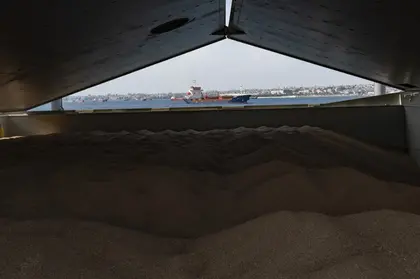Ukrainian grain exports under the ‘Black Sea Grain Initiative’ have been nearly halved during May as a result of inspection delays, and the entire seaborne grain deal could be at risk while Ukraine’s European export routes are under pressure.
During May 7 and 8, necessary inspections of ships were suspended “due to the actions of the Russian side,” according to Ukrainian officials. The inspections are conducted under the auspices of the United Nations Joint Coordination Center, set up in Istanbul to implement the grain deal, by joint teams from Turkey, the Russian Federation, Ukraine and the UN.
- View the most up-to-date Ukraine news articles published today.
- Obtain the most current Ukraine news articles released today.
JOIN US ON TELEGRAM
Follow our coverage of the war on the @Kyivpost_official.
According to Ukrainian authorities, due to the cessation and slow-down of inspections, as of May 9, there are currently 62 ships in Turkish waters which are awaiting the green light to be loaded at three Ukrainian ports - Odesa, Chornomorsk, Yuzhny/Pivdennyi. Bulkers take approximately 50,000 tonnes of grain cargo.
“The operation is paralyzed [in terms of] what could be and what was happening there several months or six months ago,” Ukraine’s Minister of Agrarian Policy and Food Mykola Solskyi said during the national news telethon, Ukrinform reported.
Late on May 9, officials with the Joint Coordination Center said that inspections resumed after a two-day suspension.
“The Office of the UN Coordinator and the delegation of Turkey are working closely with all sides with the aim to facilitate movements and inspections of inbound and outbound vessels within the framework of the Initiative and agreed procedures while discussions for the future of the Initiative continue,” the website of the Joint Coordination Centre posted.

Australia Сontacts Russia Over Man Captured Fighting in Ukraine
However, an analysis done by Kyiv Post reveals that there are longer-term negative trends that are likely of concern for the Ukrainian side.
Exports in April were 29 percent down from the previous month, according to UN data. For the first time since Sept. 2022, grain shipped out during April was under 3 million tonnes per month.
Kyiv Posts evaluation of available figures for the month of May to date indicates that exports are down a further 37 percent from April.
Exports are also down by 46 percent from the monthly average during the 10-month-old grain deal.
The first week of May – with a total of 11 loaded bulkers leaving Ukrainian ports – saw the lowest amount of activity under the grain deal during 2023.
The rate of daily inspections of ships during May is 2.9 per day – which is the lowest since the deal commenced.
The Black Sea Grain Initiative was initially agreed to run for 120 days starting from July 22, 2022. It was then renewed in Nov. 2022 for another 120 days and extended again on March 19, 2023.
As reported by UkrInform, according to Oleksandr Kubrakov, Ukraine’s Deputy Prime Minister for Reconstruction, and Minister of Communities, Territories and Infrastructure Development, the agreement was extended for another 120 days.
However, the Russian side has declared that the agreement will be valid until only May 18. The Ukrainians maintain that they have a back-up plan should the Black Sea arrangement be ended.
During the first two terms of the agreement, over 25 million metric tons of grain and food products were exported, including more than 480,000 metric tons of wheat shipped under the World Food Programme (WFP) to support its humanitarian operations in hunger-struck spots around the world.
In 2022, Ukraine supplied more than half of the WFP’s global wheat grain procurement, as was the case in 2021.
The single largest recipient under the grain deal is easily China – with some 30 percent of all grain exported - which is followed by Spain.

Corn accounts for 50 percent of exports under the deal with wheat at 28 percent and sunflower products at 10 percent.
Often called the breadbasket of Europe, Ukraine has some 42 million hectares of agricultural land. Prior to Russia’s full-scale invasion, in 2021, Ukraine’s agricultural exports totalled over $27 billion, accounting for 41 percent of the country’s overall exports, according to the US Department of Agriculture.
Specifically, the country is a major producer and exporter of staple grains—vital commodities for the international food system including the humanitarian WFP.
Prior to the war, Ukraine was first in the world in the production of sunflowers, fourth in corn, and fifth in wheat.
You can also highlight the text and press Ctrl + Enter






